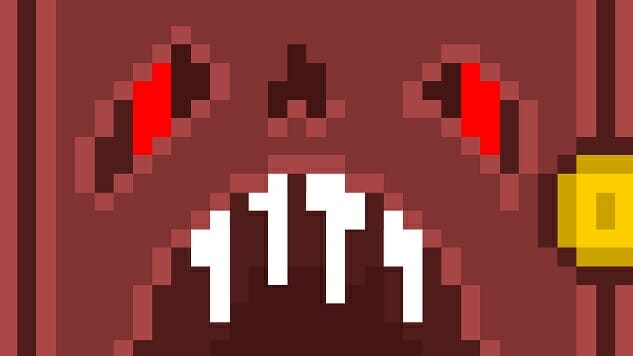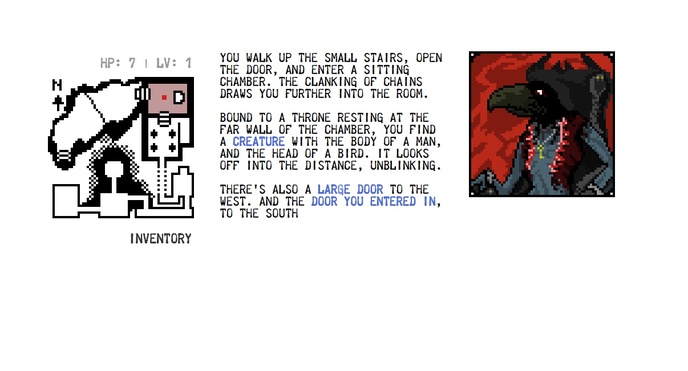
I’ve always been fascinated by the process of creation. I love watching behind-the-scenes features on movies I like. I’m interested in seeing what drives some of the people whose work I enjoy, and how they came to make a lot of the decisions fans and critics pick apart endlessly, as well as those everyone else takes for granted. In general, I find that the more I relate to the people who create the works I love, and the more I see them overcome obstacles similar to those I face, the more likely I might be to take something away from their work, and use their advice to break through my own mental walls and finally start working on that project I’ve been putting off.
That’s what I came to former Paste Drink contributor Nathan Meunier’s This Book is a Dungeon [This Dungeon is a Book] for—to see how a project comes to life, from start to finish. This Book is a Dungeon is an interactive fiction game embedded within a Kindle book. It sounds strange, but it’s actually fairly simple: the book portion is a development diary, chronicling Meunier’s creation process from the initial inspiration and outline of the idea, how he first considered it a single-month project (it ended up taking three times as long), and how he made a few of the key decisions along the way to both expand and constrict the scope of the game within his self-imposed time limit. At the end of the book, you’ll find a link to download the game. If you buy the game on Steam, it comes with a PDF download link of the book.
The game portion of This Book is a Dungeon is a straightforward work of interactive horror fiction. Made almost entirely in Twine (a simple game engine dedicated to creating interactive fiction quickly and easily), it takes advantage of almost every feature in the engine’s repertoire; rather than just text, it offers an inventory system, branching paths, a dungeon map, pixelated art of various monsters and chambers, and a simple combat system. For a three-month project lead by someone who had to learn how to program, it’s fairly ambitious.
It’s surprisingly cohesive, and striking in its resemblance to older Dungeons and Dragons campaigns, albeit with a fairly thick Lovecraftian polish. It captures a desperate tone by offering numerous ways to die. It’s charming, occasionally trippy, and gruesome throughout. But it also feels uninspired, a little rote. Had I not known anything about the game prior to playing it, I probably wouldn’t have made much of it. I would have played it for a couple of hours, made a wide-eyed pouty face with an accompanying “hm, not bad,” and probably forgotten about it. It’s a prime first effort, but it doesn’t deliver much of an impact, doesn’t really resonate.
And yet, my thoughts on it are tinted by my knowledge of its development process, or at least what Meunier tells us in the development diary. So I’ve become more attached to it. Knowing Meunier’s thought process after having played the game has affected my hindsight view on a few of the game’s aspects. The combat, which seemed like an unnecessary afterthought that relies entirely on dice rolls, now seems like a darling Meunier couldn’t kill after reading about how he insisted on its inclusion. The lack of checkpoints, on the other hand, makes sense from both the perspective of creating a dark, oppressive world and as a way to circumvent having to program a save system. These are the bits of information you want from a diary of how a game was made: something to make you rethink your understanding of the product, to offer insight into how process informs product.
As a whole, however, the development diary is equal parts insightful and frustrating. Meunier admits that the book portion won’t (and doesn’t) have the polish of some his earlier, advice-oriented work, but that’s not my biggest problem. Meunier says he wants the diary to be incredibly raw, but beyond a few moments of self-doubt as he begins to push his deadline from one to three months, “raw” usually means typos and coming off as a little too eager. Meunier’s not subtle here, and wears his influences on his sleeve. He makes half-cooked references to sci-fi and fantasy concepts, as well as ill-fitting movie references; Chapter titles include “SQUIRREL! No Wait, DUNGEON!” and “Masochism…Eff Yeah!”
Your mileage on the humor will vary (I don’t know that I can read something like “Mwuhahaha” without rolling my eyes). But even when Meunier isn’t trying to make you laugh, he feels distant; the diary reads more like a log of what he did than an attempt at the “raw” look at game development it wants to be. There’s also a fair amount of self-promotion of Meunier’s freelance work, his independent game studio, and his other Kindle books. There’s a line between mentioning your other work and promoting it, and the specificity with which Meunier catalogs his other projects, and the way he mentions things he’s done by name tilts it.
These two things combined stifle the book’s humanity. The diary offers plenty of useful advice, but I couldn’t help but feel entirely disengaged from the process towards the end. His most personal moments in the book have to do with finding inspiration for the game in the shower or at the grocery store. It feels shallow. Still, it has some valuable insights; here’s the most important one:
“If you get anything out of reading this, I hope it’s the idea that YOU can make things happen. You can do this, even if you don’t know how. You can create something awesome. You have the power to do that. You just need to DO IT. Take the first step. Dive in. Follow through. And make it happen. You’ll survive the process, hopefully, and learn a lot along the way.”
Whatever qualms I might have with his prose or approach to self-promotion, I can’t disagree.
This Book is a Dungeon was developed by Nathan Meunier and published by Black Shell Media. It is available for PC.
Suriel Vazquez is a freelance writer who read a nautical choose-your-own adventure book in grade school, drowned after being pulled under by a shark, said “that’s about right,” and put the book down. He’s written for Paste, Vice, Playboy, and several others. You can follow him on Twitter
